The Ultimate Guide to 5G Antenna
01/09/2021, hardwarebee
5G Antenna Overview
Analysis of the fifth-generation (5G) innovation is providing a clear sign of a digital revolution to fulfill the ever-increasing needs and demands for high-speed communication and Internet of Things (IoT) applications. Other IoT devices will use 5G technology to provide services such as building automation and smart cities. They will require a 5G antenna with a low latency, low path loss, and a steady radiation pattern. Antenna designs for 5G are compared in terms of their compactness, efficiency, isolation, etc. This paper presents an overview of the different 5G antenna designs.
The growth in communication has had a major influence on economic and social development in recent years. Because of this, 5G is now seen as an essential part of the future generation. Shortly, 5G will offer a range of transactional and transformational leadership services. With ultra-high data rates, very low latency, increased capacity, and good service quality, it is the next generation of technology used in data centers. Not to mention, 5G technology will allow us to overcome conventional construction barriers.
5G Antennas and Applications
There is a shift from fourth-generation (4G) mobile networks to fifth-generation (5G) mobile networks to tackle these challenges for higher data rates, improved results and increased flexibility. They should support MIMO and have a wideband. Compared to the low MIMO used in 4G, multiple-input – multiple-output (MIMO) can be a powerful component in 5G mobile communication because it can increase the data rate, channel capacity, and transmission range. When a large number of antennas are packed into cellular phones, MIMO performance can suffer.
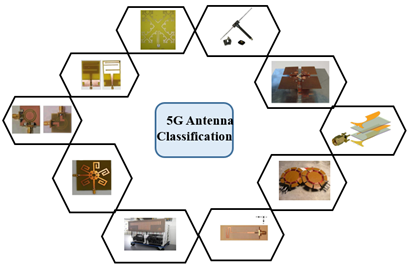
Figure 1: Classification of 5G Antennas
PIFA
For wireless circuits constructed in microstrip, a planar inverted-F antenna (PIFA) is employed. In the cell phone market, the Planar-F antenna (PIFA) is becoming more popular. The antenna is a quarter-wavelength resonant, which reduces the number of bits required on the smartphone. So the PIFA is roughly half the size of the dipole. Space is paramount in mobile devices, hence the attractiveness of IFA/PIFA designs. Also, the dipole is a balanced antenna, so typically you can’t feed it directly with a coax cable or microstrip line. A balun can address this, but it adds some additional steps to the design. Alternatively, the IFA/PIFA can be fed directly with a coax or co-planar waveguide. PIFA is mostly utilized in wireless and mobile radio transmissions. The PIFA is simple, compact, and effective in providing Omnidirectional radiation.
Monopole Antenna
The efficiency of a monopole antenna is strongly dependent on the form of retaliation that serves as the antenna’s other half. An insulated copper fill on circuitry or a metal enclosure might serve as a condition precedent. This plane, or the enclosure, is likewise referred to (connected) to the ground because the RF stage is referenced to the circuit ground. The size and placement of the ground plane counterpoise in relation to the antenna will significantly impact its voltage standing wave ratio (VSWR) and gain.
Magnetoelectric (ME) Dipole Antenna
A complementing antenna is a magnetoelectric (ME) dipole antenna. As a result, over the frequency band, the antennas have a wide impedance, a constant gain, and a steady radiation pattern with low cross-polarization and back radiation levels.
Fractal Antenna
A fractal antenna is a device that uses a recursive, identity system to improve the circumferential (on internal components or the outside structure) of material so that it may receive or transmit electromagnetic waves within a given total surface area or capacity.
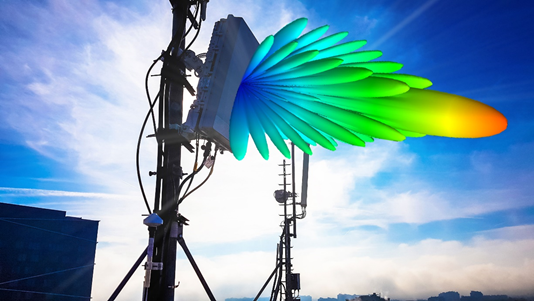
Figure 2: 5G Beamforming and Communication
MIMO Antenna
MIMO systems necessitate antenna extension and complex algorithms. Antenna arrays are pervasive on cellular devices and networks to allow communication and provide better speeds and experience design. MIMO is multi-faceted, but it’s been used in mobile technology for a long time – antenna arrays are widespread on both cell membrane devices to allow communication and provide faster rates and consumer experience. MIMO algorithms are used to manage how data is routed through antennas and where energy is focused in space. To make MIMO function, both the infrastructure and the mobile devices must work together closely.
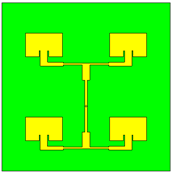
Figure 3: 2×2 MIMO Antenna
Massive Multiple Input Multiple Output (MIMO)
Unlike previous generations of mobile telecommunications, such as GSM, UMTS, and 4G/LTE, 5G does not necessitate major technological advances. Additional technologies and equipment are added to the existing LTE technology to increase data capacity and decrease congestion. The 5G NR architecture relies heavily on active antenna elements that enable multi-user MIMO capabilities. Such antenna modules use directional antennas for regulated radio contact with both receiver and the transmitter.
5G Antenna Requirements
“All-band to 5G” requires antenna systems that can support all bands. With 5G network characteristics in mind, antennas must be flexible enough to accommodate a wide array of uses. Antennas must provide the following features to be able to easily data rate and apparent data rate while fulfilling area traffic capacity and movement prerequisites:
- All-band configuration: To offer 5G NTNR capabilities, one antenna must support C Band and mmWave spectrum sources even while allowing all sub-3 GHz bands.
- Accurate beam coverage: Beam shapes must match the needs of application scenarios by concentrating beam energy on correct locations while minimizing interference with non-desired coverage areas.
Spectral efficiency is critical and necessitates antennas that can:
- Multi-user beamforming (MU beamforming) is a technique that allows numerous user beams to exchange time- and frequency-domain resources, maximizing 5G’s spectral efficiency. This can be accomplished by using precise null-steering control on antennas to prevent interference from sharing resources.
Antennas must have the following features to maximize power efficiency and connectivity density:
- Radiation concentration: To maximize the concentration of radiated energy on specified locations, antennas must provide accurate antenna pattern management in compliance with covering patterns.
- Low loss: Antenna elements are constructed so that generated loss is minimized, allowing the same radiation power to cover a higher length and breadth with the same radiation power.
Unlike 3G and 4G antennas, which have set beam patterns and directivity, 5G antennas must deliver on-demand beam coverage based on application scenarios or user demographics. 5G antennas must’ve been able to work with RAN to support beam optimization, so that accurate coverage in population centers can be delivered while disturbance is considerably reduced in other areas. Antennas must progress from being simple plug-and-play components in 3G and 4G networks to being critical network parts in 5G networks, allowing for flexible beam development and maintenance. As a result, 5G antennas will be a new form of highly integrated antenna that supports a variety of all-band configurations.
5G Antenna Market
The growing adoption of 5G technology has fueled the demand for 5G smart antennas. The number of 5G base stations projected to be deployed around the world in the next years is expected to rise due to the rapid deployment of 5G. In France, Orange has placed almost 367 antennas, with Bouygues Telecom planning to construct 67 antennas that are now being tested and SFR 43. The number of 5G base stations deployed is expected to significantly expand due to the continued rollout of 5G technology and investment in 5G technology in North America, Asia Pacific, and Western Europe. According to a competition analysis issued by Facts and Statistics, the worldwide 5G Smart Antenna Size of the market is predicted to increase at a 60 percent annual Rate from USD 262 million in 2021 to USD 6,327 million by 2028, with a forecast span of 2020-2026. The growing use of 5G technology has fueled the growth of the 5G smart antenna market research report. The number of 5G base stations projected to be deployed all around globe in the next years is projected to rise due to the rapid implementation of 5G. In France, Orange placed almost 367 antennae, while Bouygues Telecom is slated to build 67 antennas that are now being tested and SFR 43. The number of 5G base stations deployed is expected to significantly expand due to the continued rollout of 5G technology and investment in 5G technology in North America, the Pacific Region, and Western Europe. China’s 5G base station installation is expected to reach almost 6.22 percent by the end of 2023, whereas the number of 5G base stations installed in China by the end of 2019 was over 0.13 million. The worldwide 5G smart antenna market is forecast to increase such factors. North America is likely to have the largest chunk of the worldwide 5G phased array market in terms of region. Economic stimulation by telecom companies in new 5G technologies is expected to be one of the primary factors for the worldwide 5G smart antenna market. Furthermore, Asia Pacific is predicted to have the fastest growth due to the region’s growing telecommunications industry and anticipated growth in the number of 5G subscribers in the region.
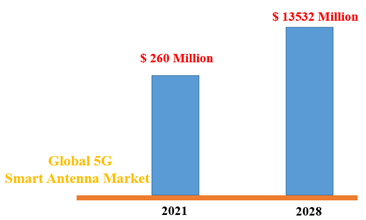
Figure 4: 5G market growth rate
Choosing an 5G Antenna
Higher 5G frequencies are beneficial for a variety of purposes; the most notable of all this is that they deliver enormous amounts of fast data capacity. They’re extremely precise, and they can cohabit with other radio communication without interfering. In comparison, 4G towers transmit signals in all directions, possibly squandering electricity. In addition, by sending radio waves to locations where high-speed access isn’t even needed. Antennas can be significantly smaller than present antennas while maintaining transport course and speed since 5G NR uses smaller wavelengths, leading to a higher frequency. 5G can support over 1,000 more applications per meter than 4G since a single base station can host many antenna arrays. This means that 5Wired connections would transmit rapid data with high efficiency and high latency to a far wider range of users.
5G Frequencies
The 5G spectrum includes radio frequencies below 6 GHz as well as millimeter-wave (mmWave) bands of 24.25 GHz and higher.

Figure 5: 5G Spectrum
5G vs 4G antenna
The excitement surrounding 5G is undeniable. The excitement around a speedier, more interconnected future is wonderful, but the actual definition of 5G isn’t apparent for so many product designers. 5G has little in common with traditional communications technology. Unlike prior technologies such as 4G, 5G does not have a standardized network. It’s more than just a refinement of prior technology; it’s a completely new set of networks for various uses.
Data Rate
Maximum rates of up to 20 GB/s, reduced signal propagation time (latency), and many mobile devices per region make all wireless experiences feel immediate, allowing potential applications to emerge. For some of us, nothing will change except for faster video feeds and a much more realistic immersive gameplay, but unknown use cases are being explored during this time.
5G Antenna Range
The signal of the 5G Ultra Wideband network can reach up to 1,500 feet without impediments in most cases. Verizon utilizes small cell technologies to assist deliver more 5G signal, hence increasing network coverage and speed. This means that in 5G-enabled locations, tiny cells will be deployed in great numbers. You should expect faster speeds and the capacity to stream movies in seconds rather than minutes on a regular basis, thanks to the increased amount of small cells used in a 5G Millimeter Wave area. 5G’s sheer speed and efficiency will help to improve connection in highly populated places.
Beamforming
Beamforming is the technique of integrating many radiating types of equipment that all transmit the same signals at the very same phase and frequency into multiple antennas with a longer, more concentrated stream created by strengthening waves in a certain location. For the very first time, the notion was employed for genderqueer radio transmissions in 1906.
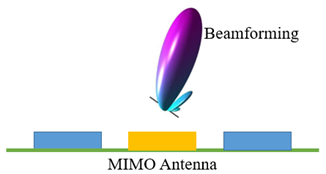
Figure 6: Beamforming











